ASUS GeForce GTX 680 & GTX 670 DirectCU II Top Edition Video Card Reviews
ASUS GTX670 & GTX680 DirectCU II Video Cards
Gamers that have the ability to spend over $350 on a graphics card have a number of cards to pick from as both AMD and NVIDIA have released great high-end videos over the past year If you are a fan of NVIDIA it doesn’t get any better than the GeForce GTX 680 and GeForce GTX 670! Both of these cards share the NVIDIA GK104 ‘Kepler’ GPU and represent the best of what NVIDIA can offer the single GPU desktop market. These are are ideal for those that game at 1920×1080 or higher with all the image quality settings cranked up. If you want to play a game and see it as designers intended, then these should be be the ones you are looking into.
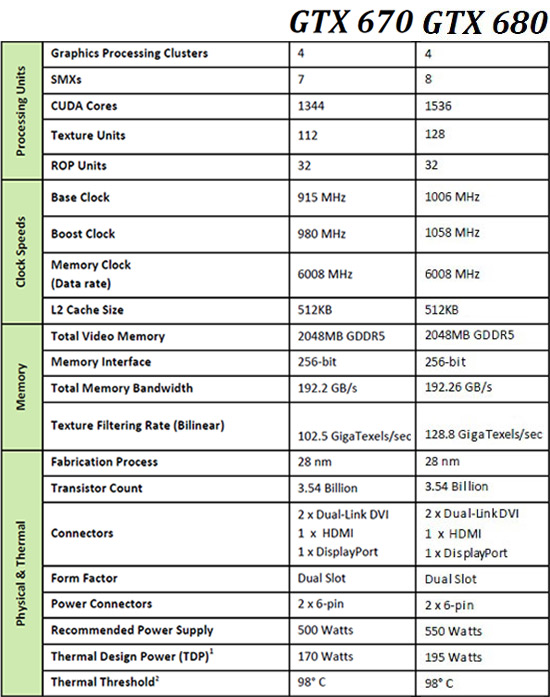
Just in case you need a reminder, here is a quick table that shows the differences between the GTX680 and GTX670. The GeForce GTX 680 has four Graphics Processing Clusters (GPCs) with a total of eight Streaming Multiprocessor (SMX) units, which is good for an impressive 1536 CUDA Cores and 128 texture units. The base clock speed of the GeForce GTX 680 is 1006MHz and the typical Boost clock speed is 1058MHz. The memory subsystem of the GeForce GTX 680 consists of four 64-bit memory controllers (256-bit) with 2GB of GDDR5 memory.
For those looking to save a buck, the NVIDIA GeForce GTX 670 has the same core with some functionality disabled and lower clock speeds on the CUDA cores. To be specific this card has just 7 Streaming Multiprocessor (SMX) units, which means it has only 1,344 CUDA parallel processing cores and 112 texture units. The base clock speed of the GeForce GTX 670 is 915MHz and the typical Boost clock speed is 980MHz. The memory remains the same, so you you still have 2GB of GDDR5 video memory, running at 6,008MHz over a 256-bit memory interfaces to seal the deal.
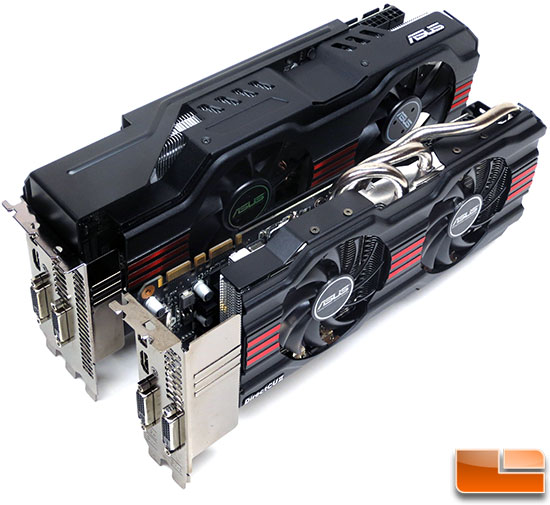
Over the past half year the GeForce GTX 670 and GeForce GTX 680 have had a number of driver improvements and add-in board makers like ASUS have made truly beautiful custom designed cards that are worth a closer look.
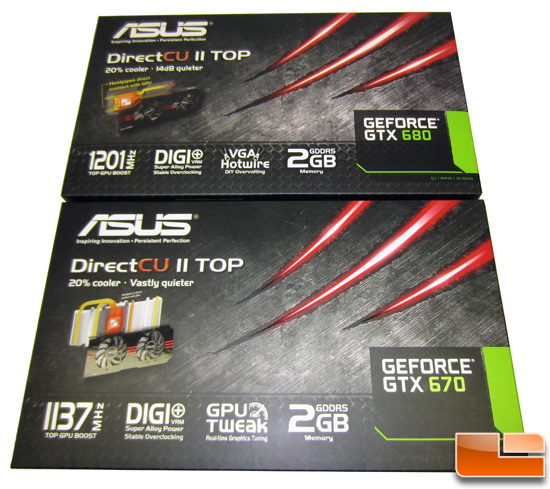
Today, we will be looking at two versions of the aforementioned cards that were manufactured by ASUS and are the DirectCU II TOP edition versions. These cards have very similar ASUS centric design specs (VRM, PCB and Heatsink), so we figured we’d cover both cards at once. We’ll also be using the just released GeForce 310.33 drivers to test the performance of these high-end graphics cards! No review is complete with comparisons, so they will be competing against the Sapphire Radeon HD 7950 Vapor-X and the Sapphire Radeon HD 7970 Vapor-X.
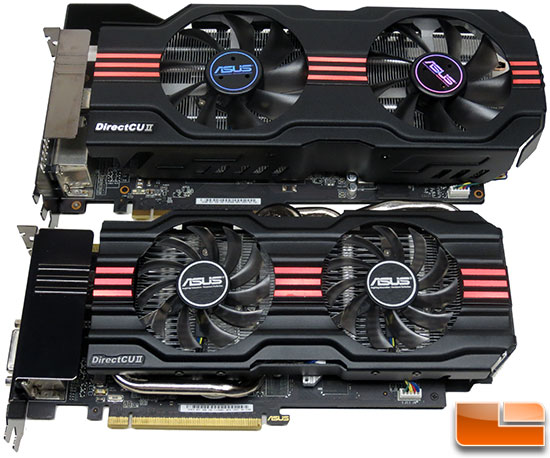
The ASUS GeForce GTX 680 DirectCU II TOP 2GB video card is a triple slot card with a base clock of 1137MHz and a boost clock of 1202MHz on the 1536 CUDA cores. The 2GB of GDDR5 memory runs at 1502MHz (6008MHz effective). The card is just shy of being a foot long (11.8″) and weighs in a 2.625 pounds (1.19 KG), so this is a pretty large graphics card!
The ASUS GeForce GTX 670 DirectCU II TOP 2GB video card is a dual-slot card with a base clock of 1059MHz and a boost clock of 1137MHz on the 1344 CUDA cores. The 2GB of GDDR5 memory runs at 1502MHz (6008MHz effective) just like on the GTX680 card. The ASUS GeForce GTX 670 DirectCU II TOP 2GB card is 10.5-inches in length and is 1.8125 pounds (0.82 KG), so it is smaller and lighter.
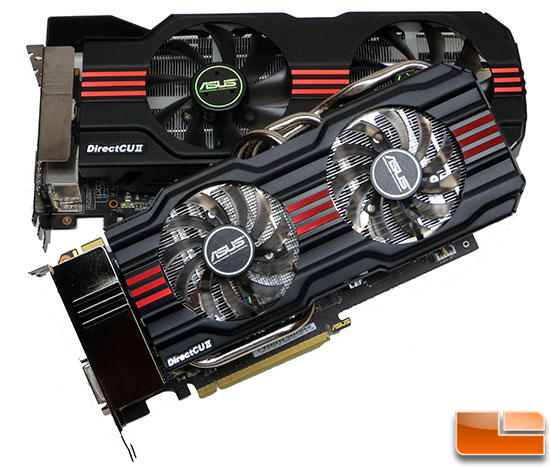
The DirectCU II cooler on the GTX 680 has a pair of directional 100mm fans which feature dust proof bearings for a claimed 25% increase in lifespan. ASUS says this cooler keeps the card 20% cooler and up to 14 decibels quieter than the NVIDIA reference design. ASUS has also upgraded the components on this card by using DIGI+ VRM with 10-Phase Super Alloy Power technology. The GTX 670 card boasts many of the same features, but uses smaller cooling fans with a different blade count and DIGI+ VRM with 8-Phase Super Alloy Power technology. The VRM assembly (Mosfets) is outfitted with a small independent heatsink on each card for enhanced cooling of the power management components.
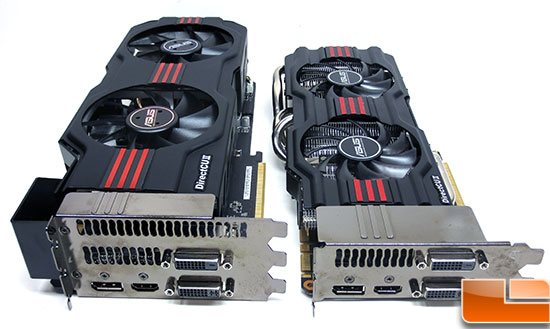
Both cards share identical video connectors, so you have a dual DVI connectors, a single HDMI 1.4a and one DisplayPort output. Both of these ASUS DirectCU II cards are compatible with a 3+1 monitor setup for NVIDIA Surround and 3D Vision Surround.
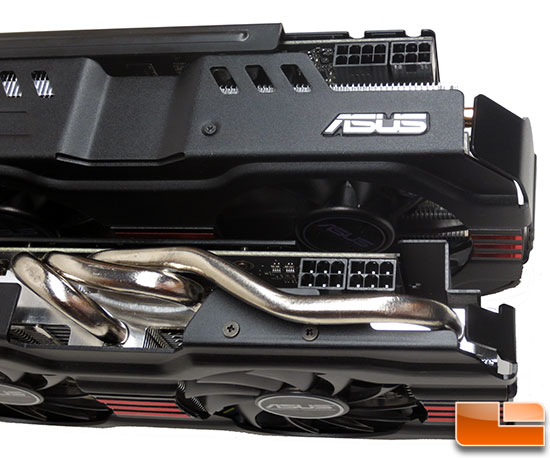
When it comes to power, ASUS has retained the NVIDIA reference design requirements and included a an 8+6 pin power connector layout for the GTX680 and a 6+6 pin power connector layout on the GTX 670. ASUS recommends a 500W power supply for the GTX670 and a 550W power supply for the GTX680. Both power supplies should have at least 38Amps on the +12V rails.
ASUS has a pair of LED lights under each PCIe power connector. These two
LED lights are a form of quick diagnostic for issues when connecting
power to the video card. Depending on the presence or lack of presence
of power connections ( or secure fitting ) the card will display an LED –
RED or Green. Green meaning power connections are correct and Red
meaning power connections are not.
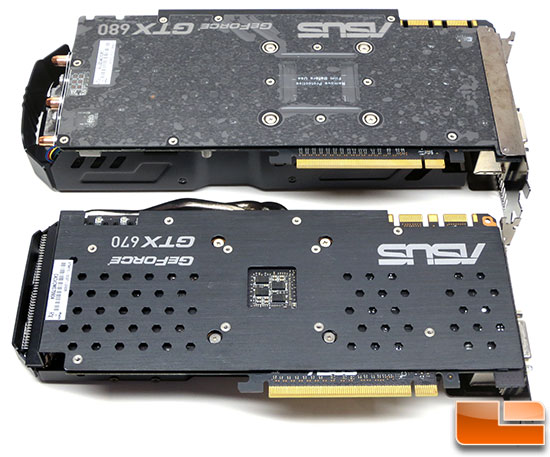
Both cards have a large black backplate to help with heat dissipation and keep the PCB from bending over time. We like that the ASUS branding is silk screened onto the card so that you can read when through a case’s side panel when installed.
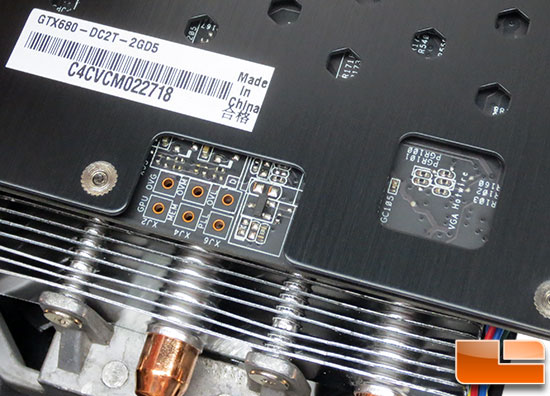
The ASUS GeForce GTX 680 DirectCU II TOP 2GB video card has one feature that we need to take a second and highlight called ASUS Hotwire. Flipping the card over you can see the ASUS Hotwire cutout that allows overclockers to hardwire the core, memory and PLL voltage points on the card to a supporting ASUS RoG Extreme series motherboard. The three measurements: GPU voltage (GPU OVG), memory voltage (MEM OVL) and PLL voltage (PLL OVL). Two wires are needed for each one and female plugs are needed at the other end for the Extreme PCB pins. Once the wiring is complete, one can do hardware-level voltage changes and accurate monitoring.

Comments are closed.